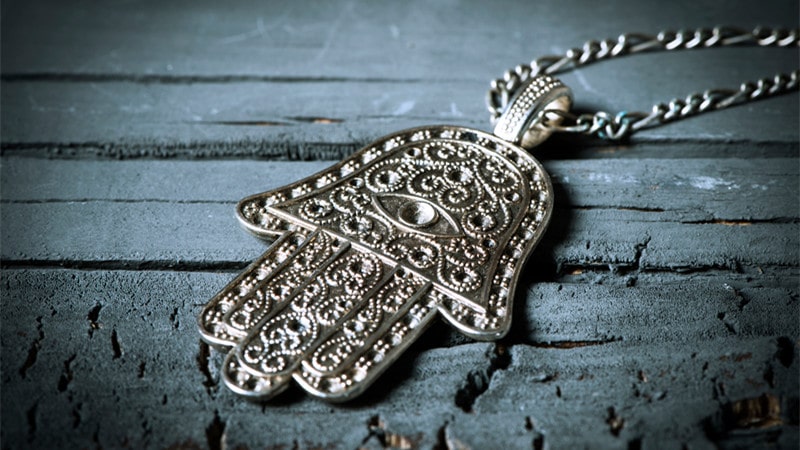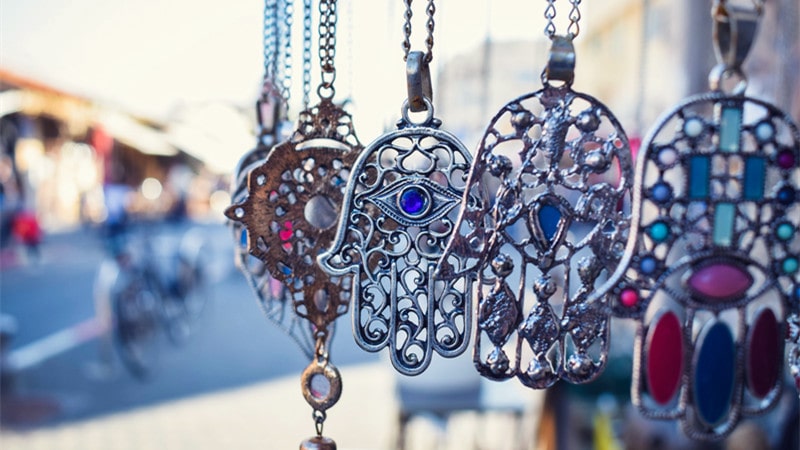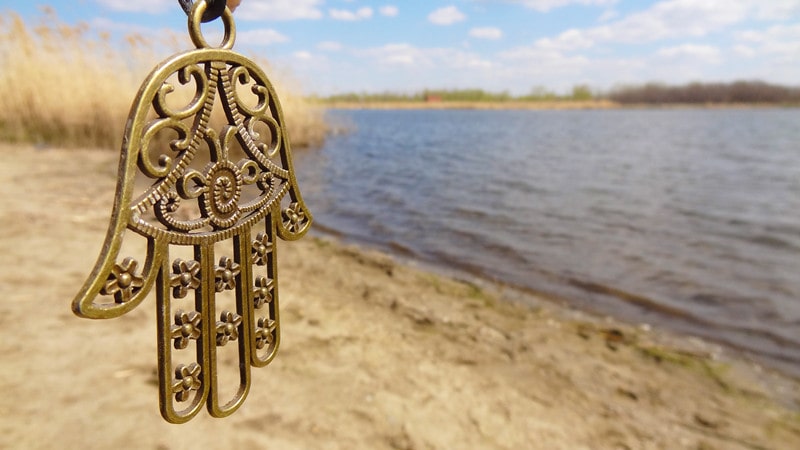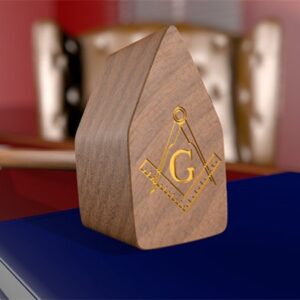
Although many people assume that the Hamsa hand is a Buddhist symbol, the truth is that it has been used in various religions, including Christianity, as a symbol of protection from the god a person follows.
In fact, in the 1800+ years that the symbol has been used, the Hamsa hand meaning has changed throughout the generations, and if you’re curious about how its meaning has changed throughout time, you’ve come to the right place.
Introduction

The Hamsa hand is a very famous symbol that most people are familiar with, and it is quite often found in various types of jewelry such as necklaces and even earrings.
The amulet comes in various sizes and even designs, and most of them are quite colorful indeed. The colors and patterns can change depending on the company that makes them, and not only are they iconic symbols of religious faith, but they are eye-catching and attractive as well.
The symbol used for the Hamsa hand dates back to ancient Mesopotamia (present-day Iraq) and Carthage (present-day Tunisia), and it is especially important in North Africa and the Middle East.
In Hebrew, Hamsa means “five,” and the symbol has been used in Christianity, where it is called the Hand of Mother Mary; and in Judaism, where it is often called the Hand of Miriam, the latter being the sister of Aaron and Moses.
But it isn’t just Jews and Christians who have used this symbol as a sign of their faith and their confidence that their god will protect them from evil. Other religions and even other cultures have used the Hamsa hand to mean something important to their followers, and they are broken down as follows.
The Meaning in Buddhism and Hinduism
Both the Buddhist and Hindu religions associate the Hamsa hand with the word “five”, the five elements, the chakras, and the mudras. The Hamsa hand consists of five fingers (naturally), and the word “hamsa” translates into “five” in Hebrew. but the symbol predates all religious faiths so it has come to mean much more than that.
In Buddhism, the symbol comes from the Arabic word for the five fingers of the hand, and it is pronounced “khamesh.” In fact, in most ancient Middle Eastern cultures the hand on the amulet stood for the “Hand of God,” and it was thought to protect its wearer against evil spirits or the “evil eye,” which is prevalent in some cultures even today.
In addition, both Buddhists and Hindus believe that the Hamsa hand represents the flow of energy from each of the chakras found in your body, as well as the five senses and mudras.
To them, each finger located on the Hamsa hand represents a certain chakra in your body as well as a particular element. Mudras are symbols or gestures that can apply to the whole body but are usually only significant to the hand and finger area.
The fingers on the Hamsa hand are each thought to specialize in their own energy form, as displayed right here:
• Thumb: fire element, solar plexus chakra (the Manipura)
• Forefinger: air element, heart chakra (the Anahata)
• Middle finger: ethereal elements, throat chakra (the Vishuddha)
• Ring finger: earth element, root chakra (the Muladata)
• Pinkie finger: water element, sacral chakra (the Svadhishthana)
For Buddhists and Hindus, these energies are often combined to change the energy flow in your body, which means they can then heal people with both physical and psychological ailments.
Meaning in Judaism
In Judaism, the Hamsa hand is also spelled as either “khamsa” or “hamesh”, and it is thought to be a way to honor their god by using all five senses. Hamsa hands can be worn as jewelry or used as decorations in their homes.
Although the hand is shown facing both up and down in modern culture, it usually faces downward in Judaism as a symbol of God’s outstretched hand as He helps mankind.
But this isn’t where the significance of the symbol stops in Judaism. The number five also has holy connotations in the Jewish faith. It can represent the Torah’s five holy books and even the five names given to their god, as well as the wearer praising God by using all five senses. As you can see, there are many similarities when it comes to what the Hamsa hand means when you compare it across religions.
If you look at the middle of the Hamsa hand, you might notice an eye or even a fish. This was done on purpose and has meaning just like all other aspects of the hand. The eye is thought to counteract the Evil Eye and thwart its attempts to wreak havoc in your life.
Much like the eye, the fish is also thought to counteract the Evil Eye and can refer to the part of the Talmud where the descendants of Joseph received blessings from Jacob by multiplying like fish, which is referred to in the Book of Genesis.
Besides fish and eyes, in Judaism the Hamsa hand also holds the Star of David, the Shema, prayers for the traveler, and even the colors red and blue, which are both believed to ward off the Evil Eye.
The Hamsa hand also has a lot of significance in the Jewish practice of Kabbalah, which has soared in popularity in recent years due to the number of celebrities involved in the practice. For these and many other reasons, the Hamsa hand shows no signs of waning in popularity within the Jewish and even non-Jewish culture.
Meaning in Islam
The two main sects of Islam – Sunni and Shi’te – each have different interpretations of what the Hamsa hand symbolizes. The Sunni consider the hand to represent the five pillars of Islam, while the Shi’te sect considers it representative of the Five People of the Cloak.
In most Islamic cultures and populations, it is known as the Hand of Fatima instead of the other possible names. Fatima was the daughter of the Prophet in the Muslim faith, and the five pillars of Islam include a profession of faith, prayer, almsgiving, fasting, and pilgrimage.
Meaning in Christianity
In Christianity, the Hamsa hand is often called the Hand of Mother Mary and it usually signifies blessing and fertility. While many Christians feel that wearing religious symbols of any kind should be avoided, many Catholics in particular love the Hamsa hand because it gives praise to Mary, the mother of Jesus.
In the end, it is up to you whether you want to wear this type of jewelry, but most people believe that no religious icons will cause you harm unless it is worn with bad intentions.
Some Interesting Facts About the Hamsa Hand

One of the most interesting facts about the Hamsa hand is that most historians believe it was never designed to be a religious item in the first place. It was, however, meant for protection and was originally carved out of silver because silver is thought to hold magical powers and represent purity as well. Below are a few other interesting facts about the Hamsa hand.
• It is always designed to represent an open right hand
• They were often hung over the doors of people who needed extra protection, such as expectant mothers and babies
• The Hamsa hand is a national symbol in Algeria and is even found in its emblem
• When the hand faces up, it is a symbol of protection against evil and against negative inner thoughts such as jealousy, insecurities, and hatred
• When the hand faces down, it is a symbol that you are welcoming goodness into your life in the form of friendship, grace, and kindness
If you’re wondering which items are made out of the Hamsa hand, they include all types of jewelry, including bracelets, necklaces, earrings, charms, and rings; as well as other items such as t-shirts, jewelry and trinket boxes, wall hangings, hanging art pieces, copper offering bowls, wind chimes, keychains, stickers, cake pans, day planners, and hundreds more items.
In fact, if you’re looking to enjoy the Hamsa hand in any form, you’ll have a lot of items to choose from every time.
Conclusion
The Hamsa hand has been around for more than 1800 years and was not originally meant as a religious symbol but a symbol of protection instead, especially against the Evil Eye.
Nowadays, there are many versions of the Hamsa hand meaning to accommodate a variety of cultures and religions, but all of them refer to the number five since Hamsa means “five” in Hebrew and represents the five fingers of the hand in Arabic.
The Hamsa hand is always a beautiful symbol and is designed in a variety of colors and sizes. Most of the time, the hand itself faces down but sometimes it faces up instead.
The main purpose of the Hamsa hand is to protect the wearer from danger and negative thoughts, especially against the Evil Eye. It is regaining its popularity due to the surge in the popularity of Kabbalah, a type of practice in the Jewish religion.
Lots of religions use the Hamsa hand to protect themselves and to remind themselves that their god is always the ultimate protector.



